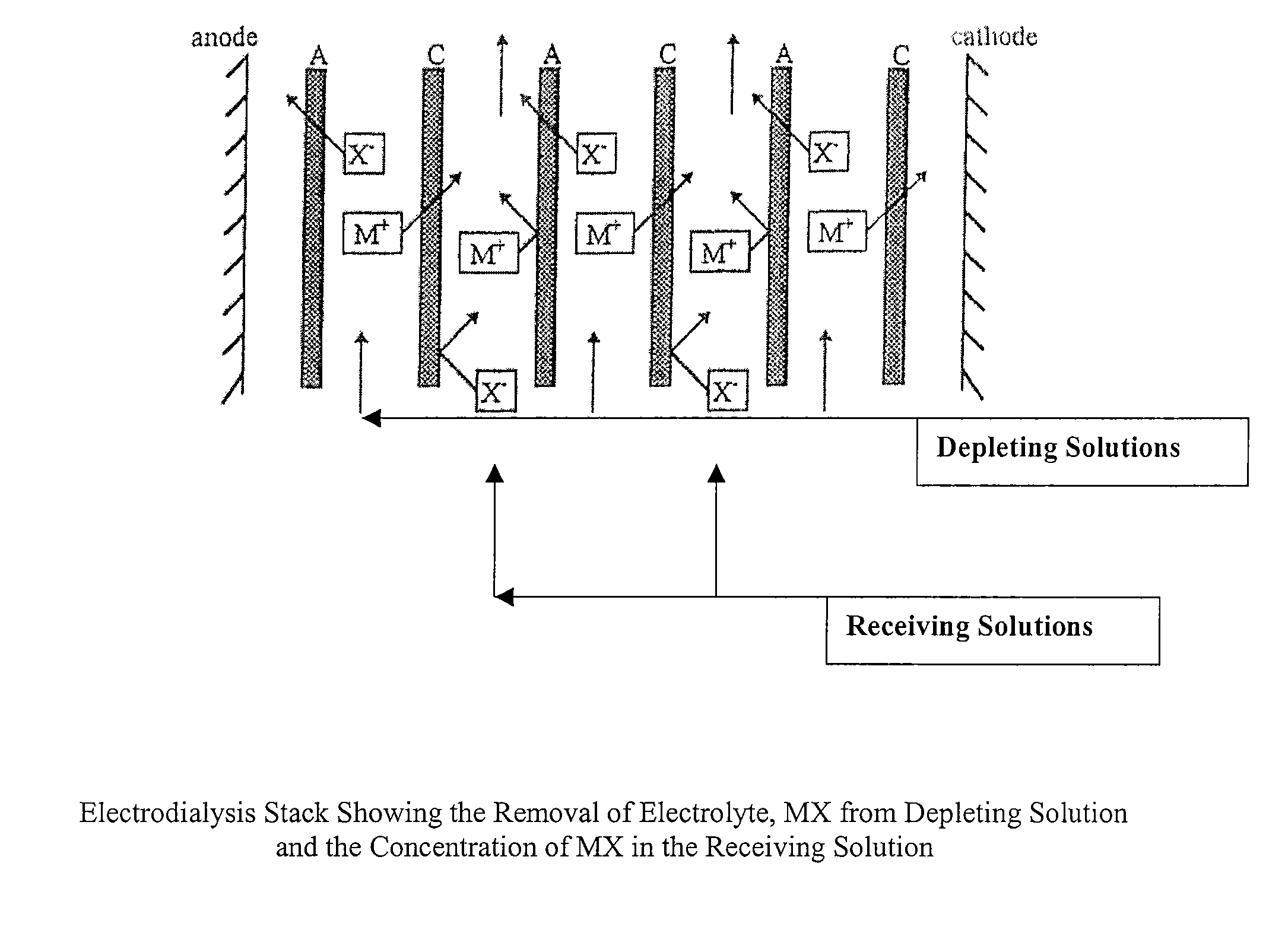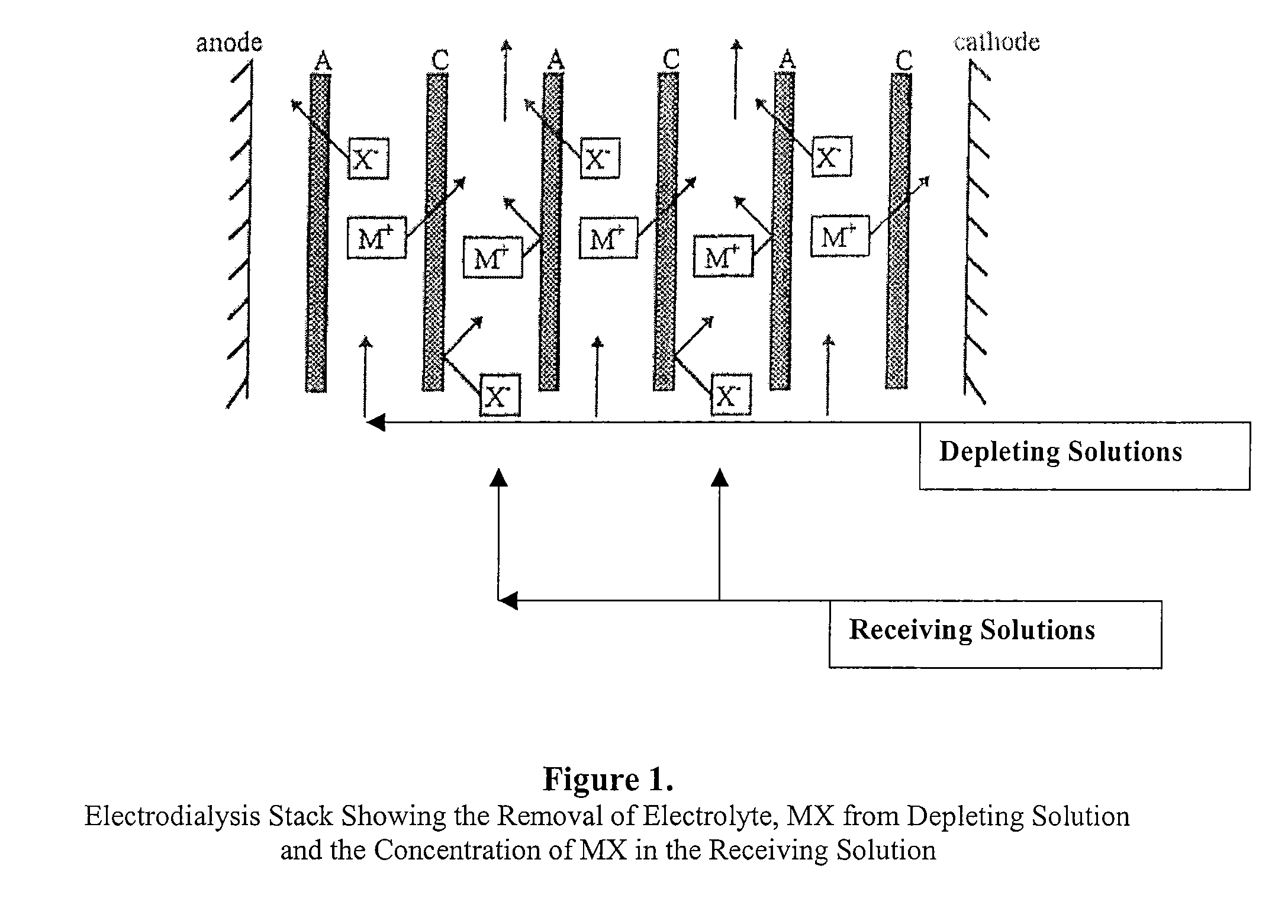Polyaluminum Chloride and Aluminum Chlorohydrate, Processes and Compositions: High-Basicity and Ultra High-Basicity Products
a technology of aluminum chloride and aluminum chlorohydrate, applied in the direction of liquid/fluent solid measurement, fluid pressure measurement, peptide, etc., can solve the problems of increased basicity, higher cost of aluminum metal in comparison to other sources of aluminum, and high manufacturing cost of high-basicity and ultra high-basicity products
- Summary
- Abstract
- Description
- Claims
- Application Information
AI Technical Summary
Benefits of technology
Problems solved by technology
Method used
Image
Examples
example 1
Production of High-Basicity PAC
[0109] Electrodialysis Stack: Eurodia 6 (20 membrane pairs)
[0110] Temperature 60° C.
[0111] Membranes: Neosepta CMX and ASM
[0112] Starting Materials: 40% PAC, Holland Chemical PACL-300
[0113] Depleting: 40% PAC
[0114] Enriching Solution: CaCl2
[0115] 50 Liters of 40% PAC was diluted with 50 liters of deionized water. The solution was agitated and heated to 90° C. The solution was held at this temperature for 1 hour and then topped off with DI water back to a total volume of 100 L (to make up for evaporation). After cooling to 60° C., the resulting solution was fed to the electrodialysis stack as the depleting solution as described below.
[0116] The enriching solution was a 2 M CaCl2 solution (10 liters). The enriching solution compartments were equipped with an apparatus that allowed for the addition of Ca(OH)2 in order to maintain the pH at a value of 0.5 or greater during the course of the run. The depleting solution was also heated to and maintai...
example 2
Production of Ultra High-Basicity PAC
[0119] Electrodialysis Stack: Eurodia 6 (20 membrane pairs)
[0120] Temperature 60° C.
[0121] Membranes: Neosepta CMX and ASM
[0122] Starting Materials:
[0123] Depleting Solution: 70% PAC from Example 1
[0124] Enriching Solution: 40% PAC (diluted 1:1 with water)
[0125] 58 Liters of 70% PAC (15.4% Al2O3) was diluted with 17 Liters of water; the agitated solution was heated to 90° C. The solution was held at this temperature for 1 hour and allowed to cool to 60° C. before feeding the resulting solution to the electrodialysis stack as the depleting solution as described below.
[0126] In this example the enriching solution was comprised of 23.5 Liters of 40% PAC diluted with 3 Liters of water.
[0127] Circulation of the enriching and depleting solutions was begun and a potential gradient of 22 volts was applied to the cell (0.8 volts per membrane pair). The initial current was 50 mA / cm2. This voltage was maintained for the rest of the step and the cur...
example 3
Production of Ultra High-Basicity PAC
[0130] Electrodialysis Stack: Eurodia 6 (15 membrane pairs)
[0131] Temperature 55° C.
[0132] Membranes: Neosepta CMX and AHA
[0133] Starting Materials:
[0134] Depleting Solution: 70.4% PAC (15.9% Al2O3)
[0135] Enriching Solution: 70.4% PAC (15.9% Al2O3)
[0136] In this example 21 liters of 70.4% (15.9% Al2O3) basicity PAC was heat treated. The heat treating procedure involved heating the agitated solution of PAC to 90° C. and maintaining that temperature for a for a period of one hour. After cooling to a temperature of 55° C., 14.7 liters of this solution was charged to the reservoir of the ED stack for the depleting solution; 6.3 liters of this solution was charged to the reservoir of the ED stack for the receiving solution. A voltage of 18 volts was applied to the electrodes as circulation of the depleting and receiving solutions was begun. The initial current density was 50 mamps / cm2. The run was concluded after 22.4 moles of charge were passe...
PUM
| Property | Measurement | Unit |
|---|---|---|
| temperature | aaaaa | aaaaa |
| temperatures | aaaaa | aaaaa |
| temperatures | aaaaa | aaaaa |
Abstract
Description
Claims
Application Information
 Login to View More
Login to View More - R&D
- Intellectual Property
- Life Sciences
- Materials
- Tech Scout
- Unparalleled Data Quality
- Higher Quality Content
- 60% Fewer Hallucinations
Browse by: Latest US Patents, China's latest patents, Technical Efficacy Thesaurus, Application Domain, Technology Topic, Popular Technical Reports.
© 2025 PatSnap. All rights reserved.Legal|Privacy policy|Modern Slavery Act Transparency Statement|Sitemap|About US| Contact US: help@patsnap.com



